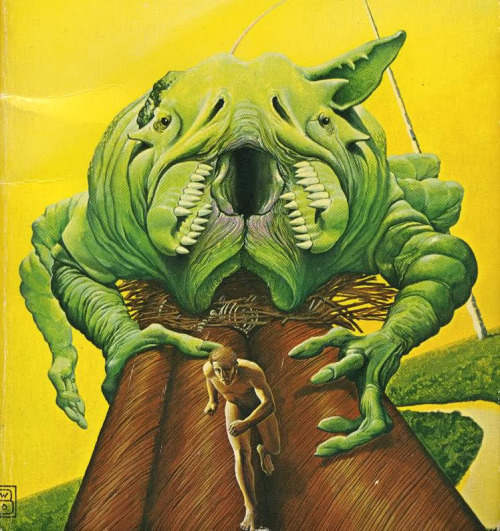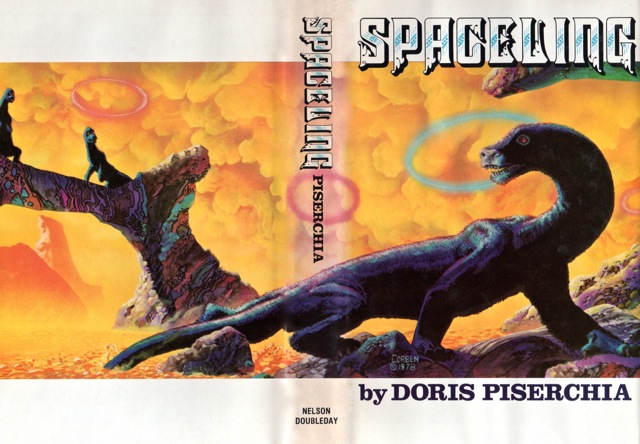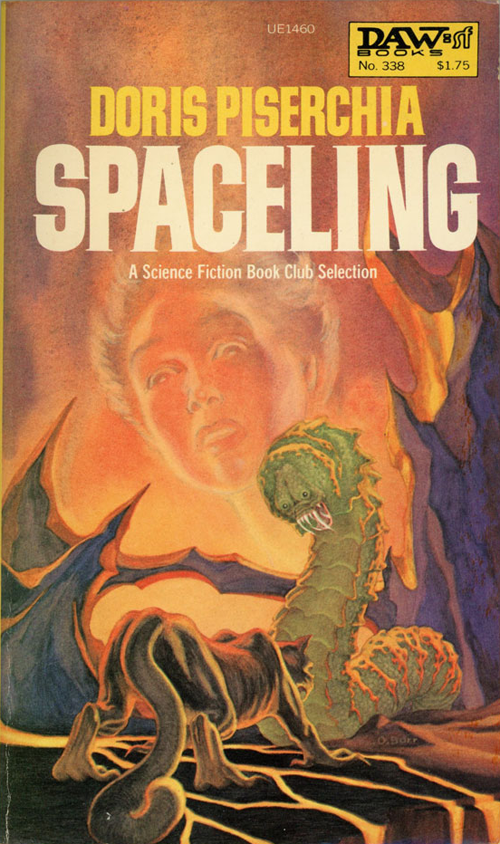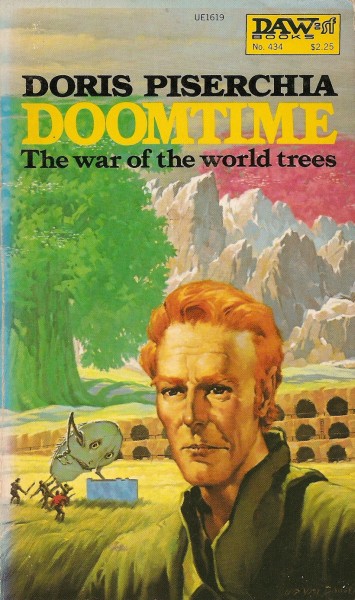Doris Piserchia is an interesting and unfortunately mostly forgotten SF writer. She had 13 books published in the decade from 1973 to 1983, mostly by DAW, two under the pseudonym Curt Selby. Then she quit writing and her books fell out of print.
Wayne Barlowe’s cover painting for Earth in Twilight.
I encountered her work browsing the eye-catching yellow spines of DAW paperbacks at a great used book store here in Kansas City called Prospero’s. The book, Earth in Twilight, had a fantastic monster painting by Wayne Barlowe on the cover. I chose other books that trip but I noted Piserchia’s name for future research. Reviews online and a comparison to Philip K Dick piqued my interest. Then I saw a hardcover of her book Spaceling at a used book store in Lawrence and couldn’t resist the garish Richard Corben cover (Corben is a fantastic cartoonist and fellow Missourian, I get his comics, especially his collaborations with Mignola, regularly).
Cover art by Richard Corben.
Spaceling is one of the weirdest books I have ever read. It’s the first-person POV of a teenage girl named Daryl who lives in a post-Peak-Oil, energy-starved Earth where some people can travel to different dimensions via floating rings. These people are called muters because when they travel to another dimension, their body and any items they bring morphs to accommodate their new environment. It’s never quite clear whether these dimensions are other planets in the universe or different universes entirely but it doesn’t really matter. The first two dimensions we encounter are a labyrinthine lava world of vicious monsters called goths, which I found amusing, and a world of endless water and floating mountains. As Piserchia develops the central mystery of her plot, she also ratchets up the psychedelic dimensions by taking us to worlds even further removed from our reality.
Daryl is in many ways a standard SF protagonist, an orphaned amnesiac who gets caught up in events of great import, but the charm of the book is in her meandering, stream-of-conscious narration. It took me a while to get into Piserchia’s prose style, where events are described in a haphazard, piecemeal fashion – some facts are clear at the beginning of a scene but other important details are not mentioned until paragraphs later – but as I relaxed into the story and the setting, I experienced it as a dream, not worrying too much about the underlying logic but just enjoying the journey, and I was happy to discover that the plot resolves satisfactorily.
Cover art by George Barr.
After reading Spaceling, I got Doomtime. It sounded the most interesting to me from reading reviews. Fortunately I didn’t have to hunt it down because Gateway has republished all of her work digitally (and Piserchia is still alive so I feel like my purchase supports her writing).
Doomtime manages to be even stranger (and better) than Spaceling.
What sets Doomtime apart is the flora and fauna of its setting, which may be an Earth of the far future but could also be another planet entirely. By escaping the somewhat-realistic setting of Spaceling, Piserchia really lets her imagination run wild. Somehow it’s easier for me to suspend any disbelief when the world is totally invented. There are two enormous trees possibly many miles in diameter (the geography of the trees gets difficult to comprehend in the final chapters), a bright green tree named Tendron and a deep vermillion tree named Krake. These trees are sentient, want to conquer the world through their expanding root network, and can communicate with their cloned offspring. People discover they can “dip” in these trees, merging flesh and consciousnesses to experience an addictive bliss. Besides these antagonists, there are the charming Dementia, an enormous land-octopus that stands on three powerful legs and loves destruction; the spiky fungus Morchella, who needs a person to dip so she can communicate between her two brains; and the little six-legged flying twirlies that spin into deadly Looney-Tunes-Tasmanian-Devil-style tornadoes.
Doomtime’s protagonist is a red-haired man named Creed. He travels back and forth across the planet, discovers new societies, and battles the trees. His actions and motivations don’t always make sense but he takes us on a fascinating psychedelic experience.
Cover art by H. R. VanDongen.
Color features prominently in Piserchia’s prose. There is the contrast between the green and red of the two warring trees in Doomtime. Daryl’s ability to precisely recall colors in Spaceling is an essential skill in navigating the inter-dimensionsal rings, where a slight difference of hue means a different destination. This focus really appeals to my visual imagination.
Piserchia conjures innovative, otherworldly creatures and environments. She lacks some of the polish of contemporary SF but she also doesn’t follow the same formulas for exposition and plot. I intend to explore her other works and I recommend that you do the same.




